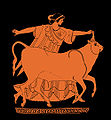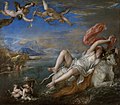യൂറോപ്പ
| Europa | |
|---|---|
 Europa and the bull, depicted by Jean-François de Troy (1716) | |
| നിവാസം | Crete |
| മാതാപിതാക്കൾ | Agenor and Telephassa or Phoenix and Perimede |
| സഹോദരങ്ങൾ | Cadmus, Cilix, Phoenix |
| മക്കൾ | Minos, Rhadamanthys, Sarpedon/ Crete |
ഗ്രീക്ക് പുരാണത്തിലെ ഉന്നത കുല ജാതയായ ഒരു വനിതയാണ് “‘യൂറോപ്പ”’(/jʊˈroʊpə, jə-/; ഗ്രീക്ക്: Εὐρώπη Eurṓpē; Doric Greek: Εὐρώπα [1]. ഇതിൽ നിന്നാണ് യൂറോപ്പ് എന്ന് ഭൂഖണ്ഡത്തിന് ആ പേര് ലഭിക്കുന്നത്.ക്രീറ്റ്| ക്രീറ്റ് ദ്വീപിലെ പുരാണകഥയനുസരിച്ച് സിയൂസ് ഒരു വെളുത്ത കാളയായി വന്ന് യൂറോപ്പയെ തട്ടി കൊണ്ട് പോകുന്നു. ഗ്രീക്ക് പുരാണകഥകൾ സംഗ്രഹിച്ച് വ്യാഖ്യാനിച്ച കരേനി പറയുന്നതെന്തെന്നാൽ സിയൂസിന്റെ മിക്ക പ്രണയ കഥകളിലേയും നായികമാർ ദേവതമാരാണെങ്കിലും യൂറോപ്പയുടെ കാര്യത്തിൽ മാത്രം വ്യത്യസ്തമാണ്[2].
യൂറോപ്പയെ പറ്റിയുള്ള ഏറ്റവും പഴകിയ സൂചന ലഭിക്കുന്നത് ബി.സി.എട്ടാം നൂറ്റാണ്ടിൽ രചിക്കപ്പെട്ട ഇലിയഡിലാണ്[3] . ഓക്സ്റിഞ്ചസിൽ (Oxyrhynchus) നിന്നു കണ്ടുകിട്ടിയ ഹെസിയഡ് രചിച്ച സ്ത്രീകളെപ്പറ്റിയുള്ള വിവരങ്ങൾ (Greek-Gynaikôn Katálogos English- Catalogue of women) എന്ന പുസ്തകത്തിന്റെ അവശേഷിച്ച താളുകളിലും യൂറോപയെപ്പറ്റി പരാമർശം ഉണ്ട്.[4] .യൂറോപ്പയുടേതായ ഏറ്റവും പഴയ ചിത്രം ബി.സി ഏഴാം നൂറ്റാണ്ടിന്റെ പകുതിയോട് അടുത്ത് വരച്ചതാണെന്ന് അനുമാനിക്കപ്പെടുന്നു .[5]
പുരാണകഥ
[തിരുത്തുക]യൂറോപ സിഡോണിലെ (ഇന്നത്തെ ലെബനൺ) രാജകുമാരിയായിരുന്നു. ഒരു നാൾ രണ്ടു വൻകരകൾ, സ്ത്രീരൂപം പൂണ്ട് തന്നെ സ്വായത്തമാക്കാൻ ശ്രമിക്കുന്നതായി യൂറോപ സ്പന്ം കണ്ടു. ജന്മം കൊണ്ട് യൂറോപ തന്റേതാണെന്ന് ഏഷ്യ അവകാശപ്പെട്ടു. മറ്റൊരു പേരില്ലാത്ത വൻകരയുടെ അവകാശവാദം വിചിത്രമായിരുന്നു- അടുത്ത ഭാവിയിൽ സ്യൂസ് യൂറോപയെ തനിക്കു സമ്മാനിക്കുമെന്ന് മറ്റേ ഭൂഖണ്ഡവും വാദിച്ചു. വിചിത്രമായ സ്വപ്ലം യൂറോപയെ വല്ലാതെ അലട്ടി, അവൾ ഉണർന്നു പോയി. നേരം പുലരുന്നതേ ഉണ്ടായിരുന്നുള്ളു. സമവയസ്കരായ സഖിമാരുമൊത്ത് യൂറോപ പൂപറിക്കാനിറങ്ങി. സ്യൂസ് ആകാശത്തിരുന്ന് ഈ കാഴ്ച കണ്ടു. പ്രണയദേവതയുടെ ശരമേറ്റ് ക്ഷണമാത്രയിൽ സ്യൂസ് യൂറോപയിൽ അനുരക്തനായി. ഒരു കാളയുടെ രൂപം പൂണ്ട് ഭൂമിയിലേക്കിറങ്ങിവന്നു. കാളയുടെ സൗമ്യപ്രകൃതി യൂറോപയെ ആകർഷിച്ചു. അതുമായി കളിക്കുന്നതിനിടയിലെപ്പഴോ അവൾ കാളപ്പുറത്തു കയറിയിരുന്നു. ആ ക്ഷണം കാള അവളേയുംകൊണ്ട് പറന്നുയർന്നു. ഭയന്നു പോയെങ്കിലും ഇതു വെറുമൊരു കാളയല്ലെന്നും ദേവന്മാരിൽ ഒരാളായിരിക്കണമെന്നും അവൾ അനുമാനിച്ചു. താൻ സ്യൂസാണെന്നും യൂറോപയെ ക്രീറ്റ് എന്ന തന്റെ സ്വകാര്യദ്വീപിലേക്ക് കൊണ്ടു പോകയാണെന്നും സ്യൂസ് പറഞ്ഞു. ക്രീറ്റിൽ ഋതുക്കൾ വിവാഹമണ്ഡപമൊരുക്കി. യൂറോപക്ക് മൂന്നു പുത്രന്മാർ പിറന്നു- മിനോസ്, റാഡമാന്തസ്, സർപിഡോൺ. [6]
ചിത്രശാല
[തിരുത്തുക]-
യൂറോപ കാളപ്പുറത്ത്- കളിമൺ ശില്പം(480-460 BC)
-
യൂറോപയും കാളയും ചുമർചിത്രം( 480BC)
-
യൂറോപയും കാളയും ചുമർചിത്രം (43BC)
-
യൂറോപയെ തട്ടിക്കൊണ്ടു പോകൽ
-
യൂറോപയുടെ ബലാത്കാരം: രചന -ടീഷ്യൻ(1562)
-
യൂറോപയെ തട്ടിക്കൊണ്ടു പോകൽ-രചന റെബ്രാന്ഡ്(1632)
-
യൂറോപ ആധുനിക കാലത്തെ മാർബിൾ പ്രതിമ
അവലംബം
[തിരുത്തുക]- ↑ Oxford English Dictionary (online ed.). headword "Europe": Oxford University Press. Archived from the original on 2013-12-04. Retrieved 18 May 2012.
- ↑ Kerenyi 1951, p 108
- ↑ Pierre Vidal-Naquet, Le monde d'Homère, Perrin 2000:19; M.I. Finley, The World of Odysseus, (1954) 1978:16 gives "the years between 750 and 700 B.C., or a bit later".
- ↑ The papyrus fragment itself dates from the third century AD: see Hesiodic fragments 19 and 19A.
- ↑ W. Burkert, Greek Religion (1985) I.3.2, note 20, referring to Schefold, plate 11B. References in myth and art have been assembled by W. Bühler, Europa: eine Sammlung der Zeugnisse des Mythos in der antiken Litteratur und Kunst (1967).
- ↑ Hamilton, Edith (1969). Mythology: Tales of Gods and Heroes. The New American Library, New York. p. 79-81.
പ്രാഥമിക സ്രോതസ്സുകൾ
[തിരുത്തുക]- Isidore, Etymologiae xiv.4.1
- Herodotus, The Histories, Book 1.2
- Eusebius, Chronicon, 47.7–10, 25, 53.16–17, 55.4–5
- Ovid, Metamorphoses, 862, translation by A.D. Melville (1986), p. 50
- Metamorphoses, ii.833-iii.2, vi.103–107
ദ്വിതീയ സ്രോതസ്സുകൾ
[തിരുത്തുക]- Pseudo-Apollodorus, Bibliotheke, III, i, 1–2
- Apollodorus, The Library of Greek Mythology (Oxford World's Classics), translated by Robin Hard, Oxford University Press, 1999. ISBN 0-19-283924-1
- Kerenyi, Karl, 1951. The Gods of the Greeks (Thames and Hudson)
- Graves, Robert, (1955) 1960. The Greek Myths
- D'Europe à l'Europe, I. Le mythe d'Europe dans l'art et la culture de l'antiquité au XVIIIe s. (colloque de Paris, ENS – Ulm, 24-26.04.1997), éd. R. Poignault et O. Wattel — de Croizant, coll. Caesarodunum, n° XXXI bis, 1998.
- D'Europe à l'Europe, II. Mythe et identité du XIXe s. à nos jours (colloque de Caen, 30.09-02.10.1999), éd. R. Poignault, F. Lecocq et O. Wattel – de Croizant, coll. Caesarodunum, n° XXXIII bis, 2000.
- D’Europe à l’Europe, III. La dimension politique et religieuse du mythe d’Europe de l‘Antiquité à nos jours (colloque de Paris, ENS-Ulm, 29-30.11.2001), éd. O. Wattel — De Croizant, coll. Caesarodunum, n° hors-série, 2002.
- D’Europe à l’Europe, IV. Entre Orient et Occident, du mythe à la géopolitique (colloque de Paris, ENS-Ulm, 18-20.05.2006), dir. O. Wattel — de Croizant & G. de Montifroy, Editions de l’Age d’Homme, Lausanne – Paris, 2007.
- D’Europe à l’Europe, V. État des connaissances (colloque de Bruxelles, 21-22.10.2010), dir. O. Wattel - de Croizant & A. Roba, Bruxelles, éd. Métamorphoses d’Europe asbl, 2011.
പുറത്തേക്കുള്ള കണ്ണികൾ
[തിരുത്തുക]- A metope from Sicily, carved with Europa, c. 550 – 540 BCE: the bull's face, turned head-on, clearly reveals his Near Eastern iconic antecedents
- Europa on the Greek euro coin of €2
- www.europesname.eu Archived 2017-09-19 at the Wayback Machine. A study describing the origin and artistic use of the name EUROPE in its mythical, geographic and political sense by Drs. Peter H. Gommers
- Warburg Institute Iconographic Database (ca 250 images of Europa) Archived 2016-03-10 at the Wayback Machine.






